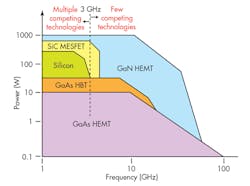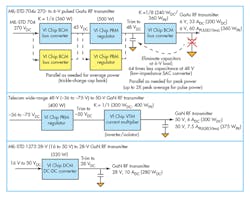Few classes of electronic apparatus make demands as challenging to power sources as RF transmitters. This is particularly true since transmission signals, with few exceptions, no longer carry continuous-wave signals, such as analog audio or video. Instead, they carry digitally encoded information as bursts of data encoded with complex modulation techniques.
On the high-power end of the application range are radars and military RF-jamming systems used by armed forces to establish safe zones in theaters of conflict. These can range from ground-vehicle deployed systems with outputs on the order of 1 kW to aircraft-mounted jammer arrays with total output power extending into the hundreds of kilowatts.
Although vehicle-deployed and airborne jamming systems might use the same signal-generation and control techniques, differences in deployment details and RF output power force otherwise similar systems to depend on different implementation technologies. This diversity within an application isn’t peculiar to the jamming application or to military electronics; many civilian RF systems exhibit similar traits.
Lower-power RF applications can be equally demanding of their power sources, particularly with regard to current dynamics and output-voltage stability during steep current-waveform transitions. Examples include communications systems for first-responder emergency personnel. Handheld radios powered by small NiMH or LiFePO4 batteries, vehicle-mounted sets powered by traditional lead-acid batteries and vehicles’ alternators, and command-center systems operating from marginally regulated ac generators exemplify the range of raw energy sources operating in this application.
A third growing segment includes wireless-telephone LTE pico cells and Wi-Fi access points for public spaces. These could include installations on the sides of city buildings to mitigate the urban-canyon effect that limits service areas of traditional cellular base stations operating in cityscapes. Lower-power versions installed in clusters help satisfy high-demand density, providing communication services in office complexes, shopping malls, sports stadia, performing-arts venues, and transportation hubs.
Of the three system examples, the pico-cell and Wi-Fi access points face the greatest data demand and, correspondingly, the highest RF channel density. High data demand doesn’t derive solely from the number of potential users; it also emerges from trends in data consumption: Traffic has shifted away from static Web pages and data accesses toward streaming video, which already accounts for more than a third of all Internet traffic and will exceed a half by 2017.1 Pico cells demand low-distortion transmission characteristics, which are critical to maximizing a site’s bandwidth utilization, connection count, and data throughput.
Compounding Matters
Designers choose different semiconductor technologies to implement the RF power amplifier (PA)—the final active stage that drives the transmitting antenna—depending on a transmitter’s operating spectrum and output power. Different output-stage criteria suggest either silicon or various compound-semiconductor technologies, each presenting its own power-supply requirements.
PA designs currently deployed use any of at least five semiconductor technologies: silicon LDMOS transistors, silicon-carbide (SiC) MESFETs, gallium-arsenide (GaAs) HEMTs, GaAs HBTs, and gallium-nitride (GaN) HEMTs (Fig. 1). Of these, GaN perhaps shows the greatest promise at high frequencies and high power.
For many years, GaAs devices dominated RF PA designs. It still accounts for a large fraction of high-frequency sockets today. However, the technology now faces several competing alternatives, particularly for systems operating at 3 GHz or less. Silicon device designs, such as LDMOS, and fabrication technologies, such as silicon-on-insulator (SOI), are compatible with high-volume fabrication processes. Therefore, they enjoy economies of scale not yet available to compound-semiconductor technologies.
Existing GaAs transmitter designs in space-constrained applications can often benefit from upgrades to one of the alternative semiconductor technologies. Typical GaAs devices exhibit efficiencies of about 45%. By contrast, GaN transmitters, for example, deliver efficiencies in the 50% to 70% range. According to MACOM CEO John Croteau, GaN provides as much as eight times the power density and greater bandwidth at high output power, allowing system designers to cut the number of output devices by factors of one-half to one-third.2
RF GaN supplier RFMD documents increased life expectancy due to lower operating temperatures compared to GaAs devices.3 The newer compound-semiconductor technology also exhibits substantially higher breakdown field strength than Si or GaAs, which supports high-voltage, high-frequency device designs (Table 1). For example, it’s common to find GaN PAs that operate at a VDS almost twice that of typical GaAs PAs and, with better efficiency, deliver higher RF-power density. GaN’s thermal conductivity is more than three times that of GaAs, further easing cooling requirements and facilitating smaller and lighter system designs for a given output power.4
As GaN technologies ramp up, some designs take advantage of its properties by using cascaded stages—a GaAs driver followed by a GaN PA stage. This combination can simplify design upgrades to take advantage of the newer technology, but it also somewhat complicates the power-subsystem design.
This file type includes high resolution graphics and schematics when applicable.
Whence the Watts?
RF applications often give rise to compatible systems operating from disparate raw energy sources, including small batteries for handhelds, HVDC for airborne systems, and universal ac inputs for fixed-location systems. Depending on application details, RF output power can range over five or six orders of magnitude. Output power, bandwidth, and functional-density requirements drive PA technology selections, which in turn determine the transmitter’s supply voltage requirement.
Despite the large range of possible input and output voltages and output currents, RF applications such as these impose important power-subsystem requirements in common. Correspondingly, these systems benefit from certain shared power-converter attributes. Key among these is the power subsystem’s transient response to high dI/dt load-current steps.
Power-subsystem design for RF applications can be approached in several ways. One separates the power block into two subsections—one that accommodates voltage characteristics of the energy source, and the other that satisfies requirements imposed by the load, particularly the RF PA.
Designers can quickly mix-and-match modular building blocks to accommodate different PA technologies, power levels, or power-source characteristics. This method works particularly well if the catalog of building blocks can cover the full range of sources and loads while depending on a minimum of external components (Fig. 2).
A modern RF system transmits in bursts. Although the transmitted signal may be an encoding of digital data, the encoded signal is analog in nature: Rapid perturbations in amplitude within the signal envelope’s bandwidth, for example, can manifest as signal-distortion products and degrade the quality of the transmission channel. Such degradation can result in lost data packets—effectively reducing data throughput and, in severe cases, data rates that can’t support certain applications (e.g., streaming video).
Burst-mode transmission systems, therefore, demand high waveform fidelity while drawing high transient currents from the power subsystem. During rapid current-waveform transitions, the power subsystem must limit the output-voltage perturbation to as small a value as possible. Residual output-voltage disturbances can appear as a variation in the RF signal output with little attenuation.
Brute-force methods of stiffening the output voltage, such as adding bulk capacitance, are usually inefficient when load currents exhibit large and rapid transitions—high dI/dt. Ultra-low equivalent-series-resistance (ESR) capacitors that can supply high dI/dt loads offer poor volumetric density. Correspondingly, high-K dielectrics provide large capacitances in small volumes, but with higher ESR and, consequently, slower response times to steps in load current.
A more effective approach is to start with power-converter architectures that natively exhibit low ac output impedances. Power trains that operate at high switching frequencies and provide cycle-by-cycle regulation minimize a converter’s dependence on bulk capacitors and their ac characteristics.
Designs that require modest output power, such as pico cells and similar applications, can right-size the power train’s output capability to accommodate load-current peaks. Combined with inherently low-noise control methods like zero voltage switching (ZVS), power-output stages can minimize dependence on bulk capacitance to supply current transients.
Power-train topologies such as sine-amplitude converters (SACs) provide voltage transformation. Examples of SAC-based power-train components include Vicor’s VTM current multiplier, which can provide up to 130 A at efficiencies up to 96%. The ability to mix and match power-train modules from a catalog of interoperating modules allows designers to flexibly address a wide range of applications and deployments with minimum power-subsystem design time (Table 2).
Conclusion
Power subsystems for pulsed-RF applications must exhibit high transient response to the load current waveform. Output-voltage stability during high-speed current-waveform excursions minimizes supply-induced waveform distortion—critical to maximizing RF-channel performance. A large catalog of mix-and-match modules allows designers to adapt to a wide range of energy sources and load requirements while optimizing the resulting power subsystem for size, weight, and power.
References:
- The zettabytes era—trends and analysis, Cisco Systems, May 2013.
- Croteau, John, The Path to Mainstream GaN Commercialization in RF and Microwave Applications, Macom, January 2014.
- Aichele, David, Emerging Market Opportunities for GaN, International Microwave Symposium, June 2012.
- Gallium Nitride (GaN) Microwave Transistor Technology for Radar Applications, Aethercomm, December 2007.
About the Author
Stephen Oliver
Vicor Corp., Power Design
Stephen Oliver, vice president of Vicor’s VI Chip Product Line, has been in the electronics industry for 18 years, with experience in applications engineering, product development, manufacturing, and strategic product marketing in the ac-dc, telecom, defense, processor power, and automotive markets. Previously with International Rectifier, Philips Electronics, and Motorola, he received a BSEE degree from Manchester University, the U.K., and an MBA in global strategy and marketing from UCLA. He holds several power electronics patents as well.





